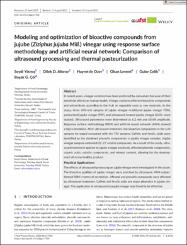Modeling and optimization of bioactive compounds from jujube (Ziziphus jujuba Mill.) vinegar using response surface methodology and artificial neural network: Comparison of ultrasound processing and thermal pasteurization

View/
Date
2022Author
Yıkmış, SeydiDülger Altıner, Dilek
Özer, Hayrettin
Levent, Okan
Çelik, Güler
Çöl, Başak Gökçe
Metadata
Show full item recordAbstract
In recent years, vinegar varieties have been preferred by consumers because of their
beneficial effects on human health. Vinegar contains different bioactive components
and antioxidants according to the fruit or vegetable used as raw materials. In this
study, three different samples of jujube vinegar—traditional jujube vinegar (TJV),
pasteurized jujube vinegar (PJV), and ultrasound-treated jujube vinegar (UJV)—were
studied. Ultrasound parameters were determined as 6.2 min and 60.6% amplitude.
Response surface methodology (RSM) and artificial neural network (ANN) showed
a high correlation. After ultrasound treatment, the bioactive components in the UJV
samples increased compared with the TJV samples. Caffeic and ferulic acids were
identified as the dominant phenolic components in jujube vinegar samples. Jujube
vinegar samples contained 22–27 volatile compounds. As a result of the study, ultrasound treatment applied to jujube vinegar positively affected phenolic components,
organic acids, volatile components, and mineral content, allowing for the development of a new healthy product.
Practical Applications
The effects of ultrasound processing on jujube vinegar were investigated in this study.
The bioactive qualities of jujube vinegar were enriched by ultrasound. ANN outperformed RSM in terms of correlation.. Mineral and phenolic compounds were affected
by ultrasound treatment. Caffeic and ferulic acids are major phenolics in jujube vinegar. The application of ultrasound to jujube vinegar was found to be effective.
Volume
46Issue
11Collections
The following license files are associated with this item:

















